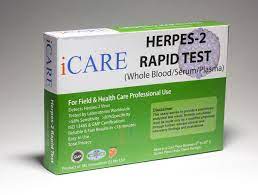Table of Contents
Introduction
Herpes Simplex Virus Type 2 (HSV-2) continues to be a significant public health challenge globally, particularly in South Africa. This article delves into the prevalence of HSV-2 in the region, the critical role of HSV-2-IGG test kits in combating this issue, and how these tools can potentially transform the landscape of herpes management.
Understanding HSV-2
HSV-2 is a sexually transmitted infection known for causing genital herpes. Its impact on individuals can range from physical discomfort to severe psychological distress. Understanding its transmission, symptoms, and prevention methods is crucial for public health.
Prevalence in South Africa
South Africa grapples with a significantly high prevalence of Herpes Simplex Virus Type 2 (HSV-2), a reality that places immense strain on both individuals and the broader public health system. Recent studies indicate that millions of South Africans are affected by this sexually transmitted infection, underscoring a pressing public health concern. The factors contributing to this high prevalence rate include limited access to comprehensive sexual education, societal stigma surrounding sexually transmitted infections, and challenges in accessing reliable diagnostic services. This situation not only exacerbates the physical and psychological burden on those directly affected but also stretches the capacity of the healthcare infrastructure, necessitating urgent and effective public health interventions to mitigate the spread of HSV-2 and improve health outcomes across the population.
Impact on Public Health
The widespread prevalence of Herpes Simplex Virus Type 2 (HSV-2) in South Africa significantly impacts the public health infrastructure, presenting substantial challenges that necessitate comprehensive management and prevention strategies. This high rate of HSV-2 not only leads to an increased demand for medical resources, including diagnostics, treatment, and counseling services, but also highlights the need for extensive public health campaigns aimed at educating the population about safe sexual practices and the importance of regular testing. Moreover, the HSV-2 epidemic underscores the critical gaps in sexual health education and access to healthcare services, especially in rural and underprivileged communities. To address these challenges effectively, South Africa’s healthcare system must implement targeted interventions that include increasing the availability of HSV-2-IGG test kits, enhancing public awareness about herpes and its consequences, and breaking down the stigma associated with sexually transmitted infections. Such measures are vital for reducing the prevalence of HSV-2 and alleviating its burden on the public health infrastructure.
Importance of Early Detection
The early detection of Herpes Simplex Virus Type 2 (HSV-2) plays a crucial role in controlling the spread of the virus and significantly improves the outcomes for those infected. Utilizing HSV-2-IGG test kits for early diagnosis is instrumental in this effort. These test kits enable individuals to identify the infection at an early stage, even before symptoms become apparent, allowing for timely intervention and management. Early detection not only facilitates prompt treatment, reducing the risk of severe complications and diminishing the physical and psychological impact on the individual, but also plays a pivotal role in preventing the transmission of HSV-2 to others. By identifying and treating HSV-2 early, the chain of transmission can be broken, significantly reducing the spread of the virus within communities. The use of HSV-2-IGG test kits for early diagnosis is therefore a critical component in the broader public health strategy to manage and mitigate the impact of HSV-2 in South Africa and beyond.
Role of HSV-2-IGG Test Kits
HSV-2-IGG test kits stand at the forefront of modern strategies to manage Herpes Simplex Virus Type 2 (HSV-2), marking a significant advancement in how individuals approach early detection and diagnosis. These kits provide a convenient and highly accurate means for people to test for HSV-2 antibodies from the privacy of their homes or in clinical settings, enabling early identification of the virus even in the absence of symptoms. The primary benefit of utilizing HSV-2-IGG test kits lies in their ability to facilitate prompt diagnosis, thereby allowing for early initiation of treatment which can reduce the virus’s severity and lower the risk of transmission to others. Early detection through these kits can also help alleviate the anxiety associated with waiting for symptoms to appear or the uncertainty of one’s HSV-2 status.
However, while HSV-2-IGG test kits are a valuable tool in the fight against HSV-2, they are not without limitations. False positives or negatives can occur, particularly in cases where the test is taken too soon after exposure before antibodies have developed to detectable levels. Additionally, the accessibility and affordability of these kits can be a barrier for some individuals, particularly in resource-limited settings. There’s also the challenge of ensuring that individuals who test positive have access to appropriate counseling and medical care to manage their condition effectively. Despite these challenges, the role of HSV-2-IGG test kits in early detection and management of HSV-2 is undeniably crucial, representing a key step forward in public health efforts to control the spread of this prevalent infection.

Home Testing: A New Frontier
The introduction of home testing kits for Herpes Simplex Virus Type 2 (HSV-2) marks a significant advancement in the realm of sexual health, offering a new level of convenience and privacy for individuals seeking to know their status. These kits allow people to conduct the test in the privacy of their own homes, without the need for a clinical visit, which can often be a barrier due to stigma, lack of access, or time constraints. This shift towards home testing democratizes access to crucial health information, enabling early detection and management of HSV-2. By simplifying the testing process, these kits encourage more people to take proactive steps towards understanding and managing their sexual health, potentially leading to a reduction in the transmission rates of HSV-2. Furthermore, the privacy afforded by home testing can significantly reduce the stigma associated with sexually transmitted infections (STIs), encouraging a more open and informed discussion about sexual health. However, the move towards home testing also underscores the importance of follow-up medical advice and support to ensure accurate interpretation of results and appropriate care. Overall, home testing kits for HSV-2 are transforming the landscape of sexual health by making testing more accessible, private, and user-friendly, thus playing a critical role in the broader efforts to manage and prevent the spread of HSV-2.
How to Use HSV-2 Test Kits
Using Herpes Simplex Virus Type 2 (HSV-2) test kits at home can be a straightforward process if you follow the provided instructions carefully. Here’s a practical guide to help you use these kits effectively and ensure accurate testing and result interpretation:
- Read the Instructions: Before starting the test, thoroughly read the instructions that come with the kit. Understanding the process and what to expect can help ensure accuracy and safety.
- Prepare Your Space: Choose a clean, well-lit area to conduct the test. Make sure the surface is sanitized and you have washed your hands properly to avoid contamination.
- Collect the Sample: Depending on the type of test kit, you may need to collect a blood sample by pricking your finger or a swab sample from the affected area. Follow the instructions carefully to collect the sample correctly. For blood samples, use the lancet provided to prick your finger, then place a drop of blood on the test strip or into the test tube, as directed. For swab samples, gently rub the swab over the area as instructed, ensuring you collect enough material for the test.
- Conduct the Test: Apply the sample to the test device according to the instructions. This might involve placing the test strip into the tube containing a buffer solution or applying the sample directly onto a test cassette.
- Wait for the Results: Each test kit will have a specified waiting time for the results to develop. It’s crucial to wait the exact amount of time stated in the instructions. Setting a timer can help ensure accuracy.
- Interpret the Results: Results are typically displayed as lines on the test device. One line might indicate a negative result, while two lines could indicate a positive result. However, the meaning of the lines can vary between kits, so refer to the instructions for accurate interpretation.
- Follow Up: Regardless of the outcome, it’s important to consult a healthcare professional for confirmation of the results and to discuss next steps. A positive result indicates the presence of HSV-2 antibodies, suggesting an infection. A negative result might mean there are no HSV-2 antibodies present, but it’s important to consider the window period and potential need for retesting.
- Dispose of the Test Kit Safely: After completing the test, dispose of the lancets, swabs, and test device as instructed, typically in a sharps container or as medical waste to prevent needle-stick injuries or contamination.
Remember, home testing kits for HSV-2 provide a convenient and private method for early detection, but they do not replace professional medical advice, diagnosis, or treatment.
Challenges and Solutions
The distribution and acceptance of Herpes Simplex Virus Type 2 (HSV-2) test kits face several challenges that hinder their effectiveness in combating the virus. Key among these challenges are stigma and accessibility. Stigma, deeply rooted in societal perceptions about sexually transmitted infections (STIs), often leads to fear, embarrassment, and reluctance to seek testing or treatment. This stigma can deter individuals from utilizing HSV-2 test kits, even in the privacy of their homes. Accessibility issues, on the other hand, include both the availability and affordability of these test kits, especially in remote or underprivileged areas where resources are scarce and awareness is low.
Solutions to Overcome These Challenges:
- Public Awareness Campaigns: Implementing comprehensive public awareness campaigns can help reduce stigma associated with HSV-2. Education plays a crucial role in changing perceptions, demystifying the virus, and encouraging open conversations about sexual health. These campaigns should focus on the importance of regular testing, the availability of home test kits, and the fact that managing HSV-2 is possible with early detection and treatment.
- Subsidizing Test Kits: To tackle the issue of accessibility, governments and non-profit organizations could subsidize the cost of HSV-2 test kits, making them more affordable or even free for individuals in need. This approach can ensure wider distribution and accessibility, particularly in areas where healthcare resources are limited.
- Partnerships with Local Communities: Collaborating with local community leaders and healthcare providers can improve the distribution network for HSV-2 test kits. These partnerships can facilitate targeted distribution efforts, ensuring that test kits reach those most in need. Community leaders can also play a pivotal role in education and destigmatization efforts, leveraging their influence to shift cultural norms and perceptions.
- Telehealth Services: Integrating HSV-2 testing with telehealth services can provide a solution to both stigma and accessibility. Telehealth platforms can offer confidential counseling, guidance on how to use the test kits, and assistance in interpreting results. This approach not only ensures privacy but also provides a support system for individuals, irrespective of their location.
- Education and Training: Educating healthcare professionals and community health workers about HSV-2, the benefits of early detection, and the use of home test kits can empower them to be advocates for sexual health in their communities. Training these key stakeholders can also improve the quality of advice and support provided to individuals who test positive for HSV-2.
By addressing the challenges of stigma and accessibility through these targeted solutions, the distribution and acceptance of HSV-2 test kits can be significantly improved, contributing to more effective management and prevention of HSV-2 in the population.
Conclusion
The fight against HSV-2 in South Africa is ongoing, but the introduction of HSV-2-IGG test kits offers a glimmer of hope. These kits are crucial in the early detection and management of HSV-2, potentially reducing its prevalence over time.






